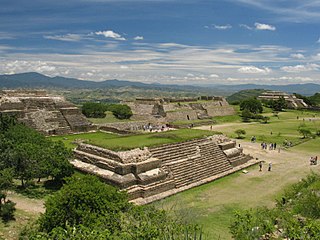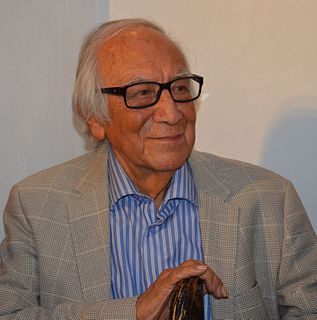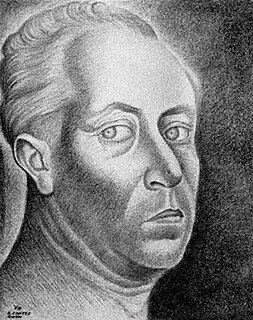
The city of Oaxaca de Juárez, or Oaxaca City or simply Oaxaca, is the capital and largest city of the eponymous Mexican state Oaxaca. It is the municipal seat for the surrounding Municipality of Oaxaca. It is in the Centro District in the Central Valleys region of the state, in the foothills of the Sierra Madre at the base of the Cerro del Fortín, extending to the banks of the Atoyac River. Heritage tourism makes up an important part of the city's economy, and it has numerous colonial-era structures as well as significant archeological sites and elements of the continuing native Zapotec and Mixtec cultures. The city, together with the nearby archeological site of Monte Albán, was designated in 1987 as a UNESCO World Heritage Site. It is the site of the month-long cultural festival called the "Guelaguetza", which features Oaxacan dance from the seven regions, music, and a beauty pageant for indigenous women.

Arturo García Bustos was a Mexican painter and print maker. He is known as one of “Los Fridos” students who studied under Frida Kahlo at her home in Coyoacán.

Carlos Mérida was a Guatemalan artist who was one of the first to fuse European modern painting to Latin American themes, especially those related to Guatemala and Mexico. He was part of the Mexican muralism movement in subject matter but less so in style, favoring a non-figurative and later geometric style rather than a figurative, narrative style. Mérida is best known for canvas and mural work, the latter including elements such as glass and ceramic mosaic on major constructions in the 1950s and 1960s. One of his major works, 4000m2 on the Benito Juarez housing complex, was completely destroyed with the 1985 Mexico City earthquake, but a monument to it exists at another complex in the south of the city.

Francisco Benjamín López Toledo was a Mexican Zapotec painter, sculptor, and graphic artist. In a career that spanned seven decades, Toledo produced thousands of works of art and became widely regarded as one of Mexico's most important contemporary artists. An activist as well as an artist, he promoted the artistic culture and heritage of Oaxaca state. Toledo was considered part of the Breakaway Generation of Mexican art.
Isidoro Ocampo was a Mexican artist during the Mexican Muralism era, best known for his graphic work. Much of his career was dedicated to teaching, which kept his artistic output low, but he was also a founding member of the Taller de Gráfica Popular and the Sociedad Mexicana de Grabadores as well as member of the Liga de Escritores y Artistas Revolucionarios and the Salón de la Plástica Mexicana.
Juan Pablo Villar Alemán is a Cuban artist specializing in drawing, painting, engraving and graphic design. Since 1989, he resides in Mexico City, Mexico.

The Benito Juárez Autonomous University of Oaxaca is a public university located in the city of Oaxaca de Juárez in state of Oaxaca, Mexico.

Luis Alberto Solari (1918–1993) was a painter and engraver from Uruguay.
Demián Flores Cortés is a contemporary Mexican artist who works in multiple media. He has worked in graphic arts, painting, serigraphy and more producing work which often mixes images from his rural childhood home of Juchitán with those related to modern Mexico City. It also often including the mixture of pop culture images with those iconic of Mexico’s past. Much of Flores’ work has been associated with two artists’ workshops he founded in Oaxaca called La Curtiduría and the Taller Gráfica Actual. This work has included events related to the 2006 uprising in Oaxaca and the restoration of an 18th-century church. His work has been exhibited in Mexico City, Europe, Guatemala and Cuba.
Francisco Díaz de León was a Mexican graphic artist, notable for pioneering much of modern Mexican graphic arts. He spent his childhood around books and when he studied art in Mexico City, he specialized in engraving and illustration. He spent his career illustrating books, magazines and more, reviving techniques such as dry point and introducing new techniques and styles such as the use of color and linoleum printing. He was also a noted arts education, directing several schools including the Escuela Mexicana de las Artes del Libro, which he founded. He was a founding member of the Academia de Artes and a member of the Salón de la Plástica Mexicana. In 1969 he received the Premio Nacional de Artes for engraving.

Pablo Esteban O'Higgins was an American-Mexican artist, muralist and illustrator.

The Graphic Arts Institute of Oaxaca is a school of art located in the city of Oaxaca de Juarez, Oaxaca, Mexico. The institute was founded by artist Francisco Toledo and hosts a large collection of artwork from Latin America.
Ángel Bracho was a Mexican engraver and painter who is best known for his politically themed work associated with the Taller de Gráfica Popular; however he painted a number of notable murals as well. Bracho was from a lower-class family and worked a number of menial jobs before taking night classes for workers at the Escuela Nacional de Artes Plásticas. Even though he had only four years of primary school, he then studied as a full-time student at the university. His art career began working with Diego Rivera on the painting of the Abelardo L. Rodríguez market in Mexico City. He was a founding member of the Taller de Gráfica Popular, making posters that would become characteristic of the group. His graphic design work is simple, clean and fine dealing with themes related to social struggles with farm workers, laborers and Mexican landscapes.
Alberto Beltrán García was a Mexican graphic artist and painter known principally for his work with publications such as illustrations and political cartoons but he created a number of murals as well. He was born in the rough neighborhood of Tepito and began drawing for local publishers when he was a teenager. He attended the Escuela Nacional de Artes Plásticas where one of his teachers introduced him to the Taller de Gráfica Popular where he began his career in earnest. From the late 1940s until his death, he work with various publications, mostly newspapers, but he also did book illustrations as well. In his later career, he worked on a number of murals, especially in the state of Veracruz, which he had an affinity for. Despite winning a number of important awards for his work, he is relatively unknown even in Mexico, with collections of his work scattered among a number of institutions.

Adolfo Mexiac was a Mexican graphic artist, known principally for his politically and socially themed work, especially with the Taller de Gráfica Popular and with fellow graphic artist Leopoldo Méndez. He also painted several murals, the most important of which deals with the history of human law at the University of Colima. In 2011, a “national homage” was held for the artist at the Museo de la Estampa in Mexico City.
Azteca de Gyves is a Mexican artist from Juchitán de Zaragoza in the state of Oaxaca. She is of Zapotec heritage and one of only two prominent female artists in her city. She has been a member of the Salón de la Plástica Mexicana since 1998 and has exhibited her work individually and collectively in Mexico, Brazil, the United States, Japan and other countries.
Jesús Álvarez Amaya was a Mexican painter and graphic artist, mostly known for mural work and his graphic work as head of the Taller de Gráfica Popular, which he led from 1967 until his death. His murals can be found in various parts of the country and his art mostly have social and political themes.

Erasto Cortés Juárez was a Mexican artist and a founding member of the Salón de la Plástica Mexicana.
Roberto Donis was a Mexican painter and art teacher. He began studying art at the Escuela Nacional de Pintura, Escultura y Grabado "La Esmeralda", but unsatisfied with the instruction, helped organize a student strike. It was unsuccessful and rather than return to school, he decided to go to Morelia to teach. Donis’ art career consisted of exhibitions both in Mexico and abroad, including an important exhibition at the Museo de Arte Moderno in Mexico City and accepted as a regular with the prestigious Galería de Arte Mexicano. His teaching career included directorship at the Universidad Autónoma Benito Juárez as well as helping to found the Taller de Artes Plásticas Rufino Tamayo in the city of Oaxaca. He received several recognitions for his work, including membership in the Salón de la Plástica Mexicana.

Sarah Jimenez Vernis was a Mexican artist known for her political graphic work in the mid 20th century, especially with the Taller de Gráfica Popular, earning her membership in the Salón de la Plástica Mexicana. After her time with the Taller, her career shifted to teaching, and her work became mostly forgotten. However, there have been efforts to revive interest in it.











